Dementia is a progressive decline in intellectual functioning that eventually compromises social and occupational functioning.1 In addition to a progressive impairment in intellectual function, there is compromise of memory and at least one other cognitive domain (see TABLE 1).2 The deterioration of cognition is described as chronic, global, and usually irreversible.3 While primarily affecting the elderly, this condition may occur at any age. In the United States, dementia affects approximately 5 million people and is attributed to 50% of nursing home admissions.3 Prevalence of dementia doubles every 5 years in the older population and reaches 30% to 50% by age 85 years. Disproportionately, women suffer as both patients and caregivers.2 In persons over the age of 65, Alzheimer’s disease accounts for approximately 75% of all dementia (TABLE 2) and vascular dementia (VD) accounts for 10% to 20%; in addition to these, the other most common dementias include Lewy body dementia, frontotemporal dementia, and HIV-associated dementia.1,3
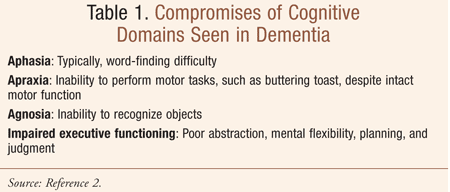
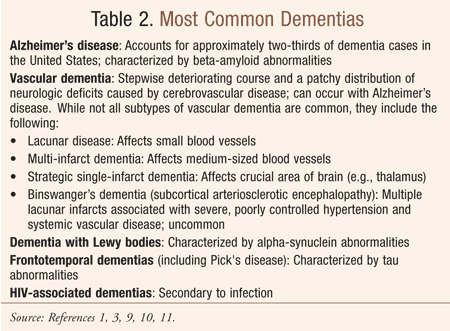
Vascular Dementia
VD, also referred to as vascular cognitive impairment, occurs in 1% to 4% of persons over age 65 years and typically begins after age 70; it is more common among men.1,3 VD is a deterioration of cognition caused by multiple small (diffuse or focal) cerebral infarcts usually related to cerebrovascular disease.3
The cognitive decline of VD may be acute or chronic; its course involves a characteristically stepwise deterioration and a patchy distribution of neurologic deficits (TABLE 3). The cerebrovascular insults cause enough neuronal or axonal loss to impair normal brain function and are responsible for the manifestations of VD (TABLE 4), including confusion and problems with memory, language, and calculations.3,4 Risk factors for VD are the same as those for stroke, including older age, hypertension, smoking, atrial fibrillation, diabetes mellitus, and hyperlipidemia.2 Profound hypotension and cerebral hemorrhage may be culprits as well.4
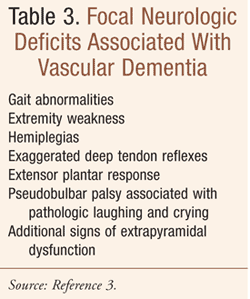
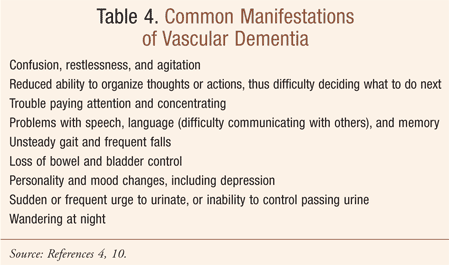
Signs and Symptoms of Vascular Dementia
Symptoms of VD often begin suddenly and worsen in a stepwise, episodic progression of intellectual decline, although symptoms can develop gradually and thus may be easily confused with Alzheimer’s disease.3,4 Decline appears to be gradual when associated with small-vessel ischemic damage due to small incremental deficits.3 In some cases of VD, symptom manifestation can be followed by modest recovery.3 Motor and focal neurologic deficits (TABLE 3) frequently develop and occur early in the course of VD as compared with Alzheimer’s disease, in which they develop late in the disease.3
One of the first symptoms of VD manifests as a decline in the ability to organize thoughts or actions (i.e., difficulty with multitasking, communicating details in a logical manner).4 While loss of short-term memory is usually the first sign in other dementias, short-term memory may be less affected in VD, with memory problems usually developing later in the course of disease.3,4 Depression may be more common in VD compared with other dementias due to the patient’s awareness of disease-related deficits (e.g., partial aphasia; see TABLE 1).3
In dementia, changes in personality and behavioral disturbances tend to develop early or late. Psychosis, hallucinations, delusions, and paranoia can occur in approximately 10% of patients with dementia; these symptoms may occur only temporarily in a higher percentage of patients.3 Behaviors such as agitation, paranoia, and physical aggression often replace clear verbal communication in people with Alzheimer’s disease, Lewy body dementia, or frontotemporal dementia (see D-BART below).5 The use of pharmacologic agents for agitation, aggression, and rage are addressed in Reference 6. With regard to seizures in patients with dementia, an increase in incidence occurs during all phases.3 Medications that have the potential to lower the seizure threshold should, therefore, be carefully considered before use and avoided if possible.
Pseudodementia and Other Potentially Reversible Disorders
Pharmacists should be aware of depression-induced dementia, referred to as pseudodementia. This condition is a reversible form of dementia in which the patient has a tendency to complain vociferously about memory problems instead of trying to conceal them.6 Treatment focuses on depression; this reversible dementia remits when depression resolves.6 Other potentially reversible disorders that may resolve with treatment include hypothyroidism and vitamin B12 deficiency, both of which can cause a slow deterioration of cognition.3
Diagnosis and Prognosis
Diagnosis of VD generally proceeds in a manner much the same as that of other dementias, as follows: 1) differentiation of delirium due to systemic problems (e.g., medications, hypoxia) from dementia, primarily by mental status examination; 2) history and physical examination; 3) laboratory testing and neuroimaging (e.g., CT, MRI) to identify treatable causes; and 4) stroke evaluation if there are signs or evidence of cerebrovascular disease.3,6 While it is difficult to distinguish Alzheimer’s disease from other dementias, assessment tools (e.g., Hachinski Ischemic Score; see Table 175-4 in Reference 3) can sometimes be helpful in differentiating vascular dementia from Alzheimer’s disease. In VD, due presumably to comorbid atherosclerotic disorders, the 5-year mortality rate (61%), is higher than that for other forms of dementia.3
Of note, severe sensory impairments in vision or hearing can underlie confusion in an elderly patient with intact cognition who is in an unfamiliar medical setting; a false label of dementia may ensue under these circumstances.2 In patients with preexisting dementia, “sundowning” (mild to moderate delirium at night) is common and may be precipitated by medications, hospitalization, and sensory deprivation.6 Compared to patients with other dementias, those with Alzheimer’s disease tend to be more orderly in appearance and better groomed.3
Prevention and Treatment
In general, the treatment for VD is similar to that of other dementias. In addition, however, while dementia shortens life expectancy, there are modalities that may prevent and slow disease progression of VD, including3:
•Blood pressure control
•Cholesterol-lowering therapy
•Regulation of plasma glucose
•Smoking cessation
While the use of FDA-approved medications for Alzheimer’s disease (cholinesterase inhibitors and memantine) are considered off label for VD—and their efficacy is uncertain for this indication—they may have some benefit, as many patients have both conditions.3,7,8
Cholinesterase inhibitors (donepezil, rivastigmine, galantamine) inhibit acetylcholinesterase, increasing the acetylcholine level in the brain. They are somewhat effective in improving cognitive function in patients with Alzheimer’s disease or Lewy body dementia and may be useful in other forms of dementia.3,7,8 Memantine, an NMDA ( N -methyl- D -aspartate) receptor antagonist, may help slow progression of moderate-to-severe dementia and can be used in conjunction with a cholinesterase inhibitor.3,7,8
Dosage formulations vary: Donepezil is available as an oral tablet and an orally disintegrating tablet; rivastigmine, as an oral capsule and solution and as a transdermal patch; galantamine, as an immediate-release tablet and solution and an extended-release capsule; and memantine as an oral tablet and solution.7,8 Recommended monitoring parameters include mental status, behavior, mood, cognitive function and general function (e.g., activities of daily living), bowel function, GI tolerance, and weight.7,8
Sedating and anticholinergic properties tend to worsen dementia; discontinuing or minimizing the use of pharmacologic agents with central nervous system activity frequently improves function.3 When signs of depression are present in patients with dementia, they should be treated preferably with selective serotonin reuptake inhibitors; antidepressants with anticholinergic properties should be avoided.3
D-BART: Skype-Based Consultation
Behaviors such as agitation, paranoia, and physical aggression are influenced by physical, psychological, environmental, and social factors and often replace clear verbal communication in patients with Alzheimer’s disease, Lewy body dementia, or frontotemporal dementia.5 There is a program, developed at the Mayo Clinic, that assists caregivers in interpreting what a patient’s specific behavior is trying to communicate in an attempt to reduce the frequency and severity of negative behaviors and at the same time improve mood and general quality of life for patients with dementia.5
This program, Dementia-Behavioral Assessment and Response Team (D-BART; see R
ESOURCE
),
evolved from an in-person–based consultation with patients and their
caregivers to a Skype-based consultation in which the patient never has
to leave his or her residential environment (D-BART, including Skype
consultation, is limited to Minnesota residents). A laptop that includes
a survey may be sent to the patient’s facility, or the team can provide
downloadable survey software to facilities that currently use Skype
technology. The team (e.g., licensed neuropsychologist, a medical
psychiatrist, and a dementia-education specialist) has established the
goal of helping caregivers comprehend that instead of expecting the
patient with dementia to change and adapt, they themselves can do so
more readily. The day before the interview, the team reviews the
patient’s electronic medical record and tests the Skype link. In order
to develop a clear picture of the patient’s behaviors, the team members
interview the patient, the patient’s family, and professional
caregivers. A group discussion is the last phase of the consultation.
The patient’s health care provider then receives a letter outlining
treatment recommendations for the patient.
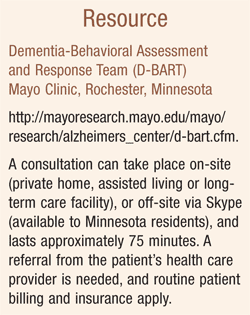
Conclusion
In general terms, VD refers to problems with reasoning, planning, judgment, memory, and other thought processes as a result of cerebral damage secondary to impaired cerebral blood flow. Understanding the risks and nuances related to the clinical manifestations of VD can assist pharmacists in tailoring their recommendations for appropriate therapy. Additionally, the potential for prevention of associated risk factors for vascular dementia is an opportunity for pharmaceutical care interventions for smoking cessation and medication therapy management for hypertension, hyperlipidemia, atrial fibrillation, and diabetes mellitus.
REFERENCES
1. Aminoff MJ, Kerchner GA. Nervous system disorders. In: McPhee SJ, Papadakis MA, Rabow MW, eds. 2012 Current Medical Diagnosis & Treatment. 51st ed. New York, NY: McGraw Hill Medical; 2012:979-983.
2. Johnston CB, Harper GM, Landefeld CS. Geriatric disorders. In: McPhee SJ, Papadakis MA, Rabow MW, eds. 2012 Current Medical Diagnosis & Treatment. 51st ed. New York, NY: McGraw Hill Medical; 2012:60-63.
3. Porter RS, Kaplan JL, eds. The Merck Manual of Diagnosis and Therapy. 19th ed. Whitehouse Station, NJ: Merck Sharp & Dohme Corp.; 2011:1673-1681.
4. Batleson JD. Vascular cognitive
impairment—a potentially preventable cause of dementia. MayoClinic.org.
February 20, 2009.
www.mayoclinic.org/medical-edge-newspaper-2009/feb-20b.html. Accessed
October 8, 2012.
5. D-Bart helps caregivers manage
disruptive behavior.
www.mayoclinic.org/medicalprofs/dementia-behavioral-assessment-and-response-team-puv3n2.html.
Accessed October 8, 2012.
6. Eisendrath SJ, Lichtmacher JE. Psychiatric disorders. In: McPhee SJ, Papadakis MA, Rabow MW, eds. 2012 Current Medical Diagnosis & Treatment. 51st ed. New York, NY: McGraw Hill Medical; 2012:1059, 1061.
7. Semla TP, Beizer JL, Higbee MD. Geriatric Dosage Handbook. 17th ed. Hudson, OH: Lexi-Comp, Inc; 2012.
8. Epocrates, Version 4.1. Epocrates, Inc. www.epocrates.com. Accessed October 14, 2012.
9. Dorland’s Pocket Medical Dictionary. 28th ed. Philadelphia, PA: Elsevier Saunders; 2009.
10. Vascular dementia. Mayoclinic.com.
April 30, 2011. www.mayoclinic.com/health/vascular-dementia/DS00934.
Accessed October 8, 2012.
11. Sutters M. Systemic hypertension. In: McPhee SJ, Papadakis MA, Rabow MW, eds. 2011 Current Medical Diagnosis & Treatment. 50th ed. New York, NY: McGraw Hill Medical; 2011:426.
To comment on this article, contact rdavidson@uspharmacist.com.





